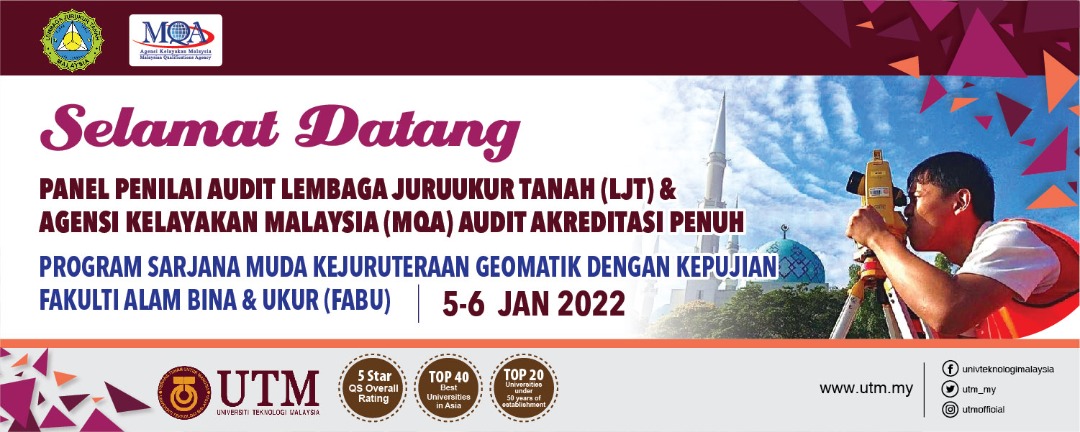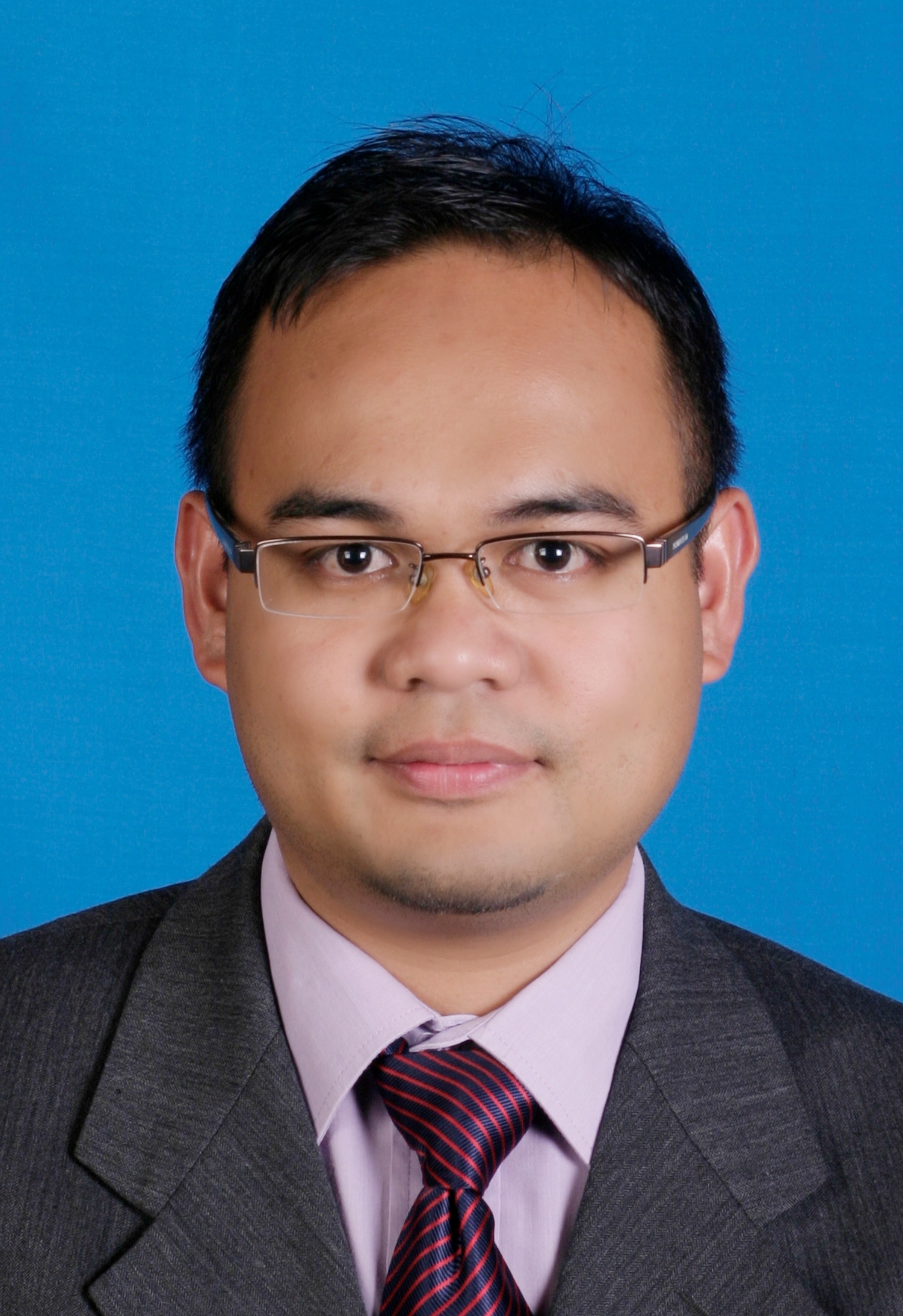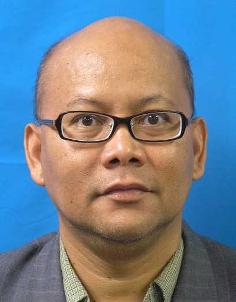


Department of Architecture

Department of Architecture
Contact Us :
Faculty of Built Environment,
Universiti Teknologi Malaysia,
UTM Skudai, 81310 Johor,
Malaysia.
Tel: +6075557350
Fax: +6075566155
Email:fab@utm.my
The Department of Architecture (Malay: Jabatan Senibina), Universiti Teknologi Malaysia (UTM) is the oldest school of architecture in Malaysia. It is one of the five schools under the Faculty of Built Environment. The origin of the school could be traced back to the early days of Kuala Lumpur Technical School, Brickfields Drive, Kuala Lumpur which was established in 1904. Its current reiteration was founded in 1975 in Jalan Gurney, Kuala Lumpur. The school later was moved to its current location in Skudai Campus, Johor during the mass migration into the larger, eventually the main campus of UTM, in 1987. Currently the UTM Department of Architecture is ranked as one of the best architecture school in Malaysia.
UTM School of Architecture
BACHELOR OF ARCHITECTURE
PROGRAMME OUTLINE
Architecture is the art and science of building. It’s activities encompass the design, development and planning of the built environment as well as managing the construction process. Architects play the key role in creating buildings and habitats that serve as integrated solutions to issues and contexts as diverse as design, research, practice, construction, socio-culture, human behaviour, history, and the environment. An architect’s design could extend from working places and simple individual living, to communal and urban living of the society. Such role demands highly professional and ethical individuals in creating better built environment. The Bachelor of Science in Architecture programme at UTM is designed to produce individuals that can fulfil this role.
The Bachelor of Science in Architecture Programme is a professional degree that is equivalent to the professional qualification of the Board of Architects Malaysia Part I, which is the first part of a two tier architecture programme. The programme emphasise on architectural design skill based studio projects and the complementary courses. Competent skills and knowledge addressed with the programme, contribute to the development of architecture within the National framework, for sustainable development.
To continuation of the Board of Architects Malaysia Part II is addressed in the Master of Architecture programme.
PROGRAMME OBJECTIVES
Four main objectives are:
- To produce graduates who are knowledgeable and competent in line with the professional qualification of Board of Architect Malaysia Part I.
- To produce graduates who are able to solve design problems based sound facts and idea.
- To produce graduates who are professionally ethical, aware and responsive to the values of humanity and sustainability.
- To produce graduates who are competitive, effectively communicative and contributive to working teams and competitive.
ENTRY REQUIREMENTS

Department of Quantity Surveying

Department of Quantity Surveying
Contact Us :
Faculty of Built Environment,
Universiti Teknologi Malaysia,
UTM Skudai, 81310 Johor,
Malaysia.
Tel: +6075557350
Fax: +6075566155
Email:fab@utm.my
The Department of Quantity Surveying was established in 1970. However, the Quantity Surveying programme was first conducted in 1952 by the Technical School. At the time the school offered a two year certificate programme in Quantity Surveying. The certificate programme was upgraded to a four year diploma programme that was reduced to three years in 1965.
In 1973, the first batch of ten students enrolled for the five year degree programme in Quantity Surveying conducted by the department. This programme ran parallel with the three year diploma programme.
In 1976 these two programmes were offered as a five year integrated programme where the first three years is for the diploma programme and another two years is for the degree programme. This programme was reduced to four years in 1998 where the first two and the half years is for the diploma programme and another one and the half years is for the degree programme.
In 1987, the department started a degree programme in Building. This programme is an extension of the integrated Quantity Surveying programme where students can choose to pursue the degree programme in Building after obtaining the Diploma in Quantity Surveying.
In 1995, the department started the post-graduate programme by research.
In 2003, UTM changed the level of ewntry requirements for all its academic programmes from the Malaysian Certificate of Education (SPM) to the Malaysian Higher Certificate of Education (STPM) and Matriculation. This change was carried out in accordance to the directive issued by the Ministry of Higher Education. In line with this, the Department of Quantity Surveying reviewed the curriculum for both the Quantity Surveying and Building programmes. The Integrated Programme in Quantity Surveying is changed to three year Degree Programme. The department also developed a new curriculum for the Degree Programme in Building and changed the name to BSc in Construction. The BSc in Construction Programme is a three-year Degree Progamme.
In 2004, the department moved a step forward by offering the MSc in Construction Contract Management programme.
Vision:
- To be a world class center for quantity surveying and construction studies.
Mision:
- To produce quality, competent and versatile graduates who are equipped with the necessary
technical knowledge, practical and generic skills to compete in the employment market.
PROGRAMME OUTLINE
Project development is an investment that involves considerable sum of money and time. Clients will expect their project to generate values from their investment. They also expect value for money from their projects which involve the element of time, cost and quality. These objectives can be achieved through technical knowledge and professional competency, economics evaluation, effective cost management and selection of appropriate construction procurement with efficient and effective contract management. The role of quantity surveyor through their education, training and experience will contribute to the effective management of construction cost, project procurement and contract administration as well as giving advice on development economics and contractual matters.
The programme has been designed to offer graduates the opportunity to operate within the existing framework of the Quantity Surveying discipline, the construction industry and related fields. At a personal level, the graduate will be stimulated to adopt a professional and ethical approach that will allow personal development, foster self-respect and improve career aspirations.
PROGRAMME OBJECTIVES
- To provide graduates with solid foundation in management and technical knowledge, skills and capabilities in the field of Quantity Surveying.
- To produce graduates who are effective problem solver, knowledgeable in applying logical, critical and creative thinking to a range of problems.
- To provide graduates with a board knowledge, leadership and managerial skills which are necessary for the effective delivery of construction projects.
- To produce graduates capable of executing their responsibilities with professionalism and capable of lifelong learning in the pursuit of personal development and betterment of society.
- To provide graduate with basic communication skill, lead effectively and able to work collaboratively in multidisciplinary team.
ENTRY REQUIREMENTS
[/su_spoiler][su_spoiler title=”BACHELOR OF SCIENCE IN CONSTRUCTION” style=”simple” icon=”plus-circle”]
PROGRAMME OUTLINE
Modern construction projects are known for their complexity in design and speed of execution. They require significant utilization of resources such as materials, manpower, equipment and finance. Most of the projects are performed under conditions of scarcity of resources and suffers from uncertainty in their supply. Work delays will result in increasing costs since there is an intricate time-cost relationship for every project. The need for proper planning and management of construction can never be over-emphasised.
The Bachelor of Science in Construction curriculum is designed to provide a solid academic base and professional expertise in the discipline of construction management, and to critically address the present and evolving needs of the construction industry. In order to perform successfully in the construction industry, students must develop an understanding of the technical aspects of construction while applying construction management practices and tools to maintain control and provide informed, optimal decisions. The programme focuses on the understanding of construction technology, construction management and production management processes. The programme also addresses the generic skills and capabilities necessary to compete in the employment market.
The programme addresses a combination of engineering technology, construction techniques and management. It is designed to prepare graduates for managerial positions in the construction industry. At a personal level, the programme will inculcate professional and ethical approach that will foster the graduates’ personal development, self-respect and career aspirations.
PROGRAMME OBJECTIVES
Bachelor of Science in Construction has five programme educational objectives:
- To provide graduates with solid foudation in management and technical knwoledge, skills and capabilities in the field of construction
- To produce graduates who are effective problem solver, knowledgeable in applying logical, critical and creative thinking to range of problem
- To provide graduates with a broad knowledge, leadership and managerial skills which are necessary for the effective delivery of construction projects
- To produce graduate who are capable of executing their responsibilities with professionalism and capable of lifelong learning in the pursuit of personal development and betterment of society
- To provide graduate with basic communication skills, lead effectively and able to work collaboratively in multidisciplinary team
ENTRY REQUIREMENTS
[/su_spoiler]

Department of Urban and Regional Planning

Department of Urban and Regional Planning
Contact Us :
Faculty of Built Environment,
Universiti Teknologi Malaysia,
UTM Skudai, 81310 Johor,
Malaysia.
Tel: +6075557350
Fax: +6075566155
Email:fab@utm.my
Brief Background of the Department
The Department of Urban and Regional Planning which was established in 1974 at UTM’s original Jalan Gurney Campus is one of the departments under the Faculty of Built Environment. Long before the Department was established, the Technical College (the predecessor of UTM) had already offered the Diploma program in urban and regional planning under the Faculty of Architecture. The Bachelor degree in urban and regional planning was first offered in 1972 when the Technical College was upgraded to the university status and renamed the Institut Teknologi Kebangsaan (ITK). Later in 1974, the Faculty of Architecture was restructured and became the Faculty of Built Environment, comprising of the Department of Architecture, Department of Quantity Surveying and Department of Urban and Regional Planning. When UTM was relocated to the present main campus in Skudai in 1985, the Department was one of the earliest to move to the new campus.
In the 38 years of the running of the Bachelor of Urban and Regional (B.URP) Program, the Department has successfully produced a large pool of professional town planners who have contributed appreciably to the nation’s development and created an image of excellence for the town planning profession at both the national and international levels. This has led to the recognition of the program by the Public Service Department (JPA) and the Malaysian Institute of Planners (MIP) since early on until the present. The Department is committed to continuously elevating the B.URP program through ongoing enhancement of the curriculum quality; staff’s caliber; teaching, learning and research facilities.
Over the years, the program has seen a series of changes in the mode it was handled. The Department first conducted the Diploma and Bachelor URP programs separately under the ‘separate system’ in 1972. In 1976, the ‘integration system’ was introduced where students entered common lower years and would opt to pursue either the Diploma or Bachelor program at Year 3. The Department reverted to the separate system in 1984 and again to the integration system in 1997. The Department last returned to the separate system in 2003 and conducted the 4-year Bachelor program in the Skudai campus while the handling of the Diploma program was transferred to the Kolej Sains dan Teknologi (KST) in the Kuala Lumpur International Campus.
As the Department gained academic maturity, a host of urban planning related postgraduate research and taught programs were introduced in early 1990s, which have now grown into successful PhD, and Master of Science (M.Sc.) programs encompassing the fields of Information Technology (IT), Transportation, Urban Design, Tourism, Environment and Resource Management, Housing, and Urban and Regional Planning. The postgraduate programs have seen steady growth in enrolment of both local and international students, which is clear testament to the quality of the programs offerred.
Vision
To be recognised as a world-class centre of excellence for urban and regional planning education and research
Mission
To be a leader in the development of human capital and innovative technologies in Urban and Regional Planning that will contribute to the nation’s wealth creation
Objectives
- To produce competent and versatile graduates
- To continuously enhance staff professionalism and excellence
- To be the referral centre for research and development and publication
- To enhance networking and collaboration with industry and institutions worldwide
- To provide good support and facilities for excellent education and research
BACHELOR OF URBAN AND REGIONAL PLANNING
PROGRAMME OUTLINE
The profession of urban and regional planning concerns with the planning, designing and managing of the built environment. It is interdisciplinary in nature and integrates both the art and science of creating a better quality of life in a sustainable environment. At the local level the profession deals with the planning and designing of neighbourhoods, towns and cities. In contrast, the profession focuses on strategic and structural planning at the regional and national level. The profession seeks to balance between society and environment by managing developments through policies, strategies and plans.
The Urban and Regional Planning programme emphasises technical, strategic and generic skills demanded of planners. Students are instilled with knowledge on principles of planning, creativity in designing and problem solving, analytical and strategic thinking, as well as competency in research and practice.
PROGRAMME OBJECTIVES
- To provide students with a range of learning experiences in acquiring relevant theories, methodologies, techniques and skills to develop a capacity for creative thinking and problem solving in urban and regional planning.
- To inculcate a culture of continual learning and innovation among students for a career in urban and regional planning in a dynamic economic, socio-cultural and environmental situations.
- To prepare students for diverse career opportunities in urban and regional planning and related fields at the local and global level.
- To instil awareness and sensitivity among students about the roles of urban and regional planning in achieving sustainable development.
- To offer quality planning education that fulfils the educational requirements of the Board of Town Planners Malaysia.
ENTRY REQUIREMENTS

Assoc. Prof. Datin Dr. Norsiah Bte Abd. Aziz
Head of Department,
Department of Urban and Regional Planning,
Faculty of Built Environment,
Universiti Teknologi Malaysia,
UTM Skudai, 81310 Johor,
Malaysia.
Tel: +6075557428 Fax: +6075566155
Email: b-norsiah@utm.my

Department of Landscape Architecture

Department of Landscape Architecture
Contact Us :
Faculty of Built Environment,
Universiti Teknologi Malaysia,
UTM Skudai, 81310 Johor,
Malaysia.
Tel: +6075557350
Fax: +6075566155
Email:fab@utm.my
Landscape architecture encompasses the art, planning, design, management, preservation and rehabilitation of the land and the design of human-made constructs, that is, the stewardship of the natural and built environments. A variety of often interwoven specializations exist within the discipline, including the following: Landscape Design, the historical core of the discipline, is concerned with detailed outdoor space design for residential, commercial, industrial, institutional, and public spaces.
It involves the treatment of a site as art, the balance of hard and soft surfaces in outdoor and indoor spaces, the selection of construction and plant materials, infrastructure such as irrigation, and the preparation of detailed construction plans and documents. The site planning and design of projects can involve designing the land specifically in terms of the orderly, efficient, aesthetic and ecologically sensitive integration of man-made objects with a site’s natural features including topography, vegetation, drainage, water, wildlife and climate. Sensitive design produces development that minimizes both environmental impacts and project costs, and adds value to a site.
Vision:
-
To produce landscape architects who are capable of designing the built environment of neighborhoods, towns and cities while also protecting and managing the natural environment, from its forests and fields to rivers and coasts. Members of the profession have a special commitment to improving the quality of life through the best design of places for people and other living things.
BACHELOR OF LANDSCAPE ARCHITECTURE
PROGRAMME OUTLINE
The programme was designed and implemented since 1993 which was inspired on the core understanding of Man as the steward of the Earth and based on the design and built philosophy. It aims to produce professionals who are competent and technically knowledgeable as well as being critical and creative in problem solving on issues pertaining to aspects of heritage, tropical, urban and natural resources.
Landscape architecture combines both art and science. It is a profession that involves the design, planning and management or exterior spaces through the use of land and water elements in creating outdoor spaces which are practical and aesthetically pleasant. The works of a landscape architect does not only add value but also provide comfortable outdoor environment in residential areas, work and playing spaces. Landscape architecture is a discipline that covers a diverse scope ranging from the design of exterior landscapes within urban, rural, communal, ecological and regional areas. Landscape architects serve not only as designers but help to create landscape that responds to human habitation in diverse cultural and ecological contexts.
PROGRAMME OBJECTIVES
The undergraduate programme in Bachelor of Landscape Architecture is designed to produce graduates who will be:
- Qualify and competent in solving design and project related problems, logically, creatively and analytically based on sound facts and ideas
- Capable to demonstrate mastery in communication skills and other relevant soft skills
- Substantially analysing and integrating natural systems with social and communal needs
- Capable of meeting the challenges of the landscape architectural environment with professional integrity and pursue life-long learning; and proficient in entrepreneurship skills
ENTRY REQUIREMENTS



